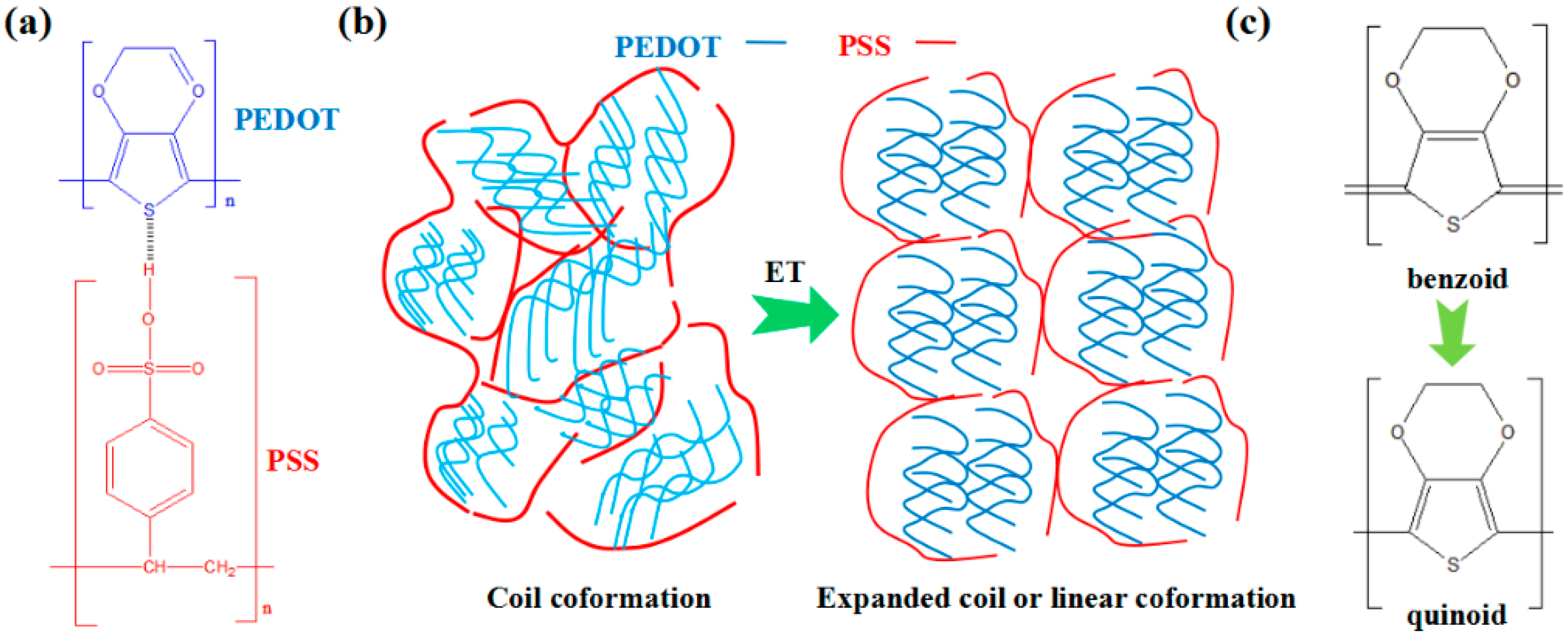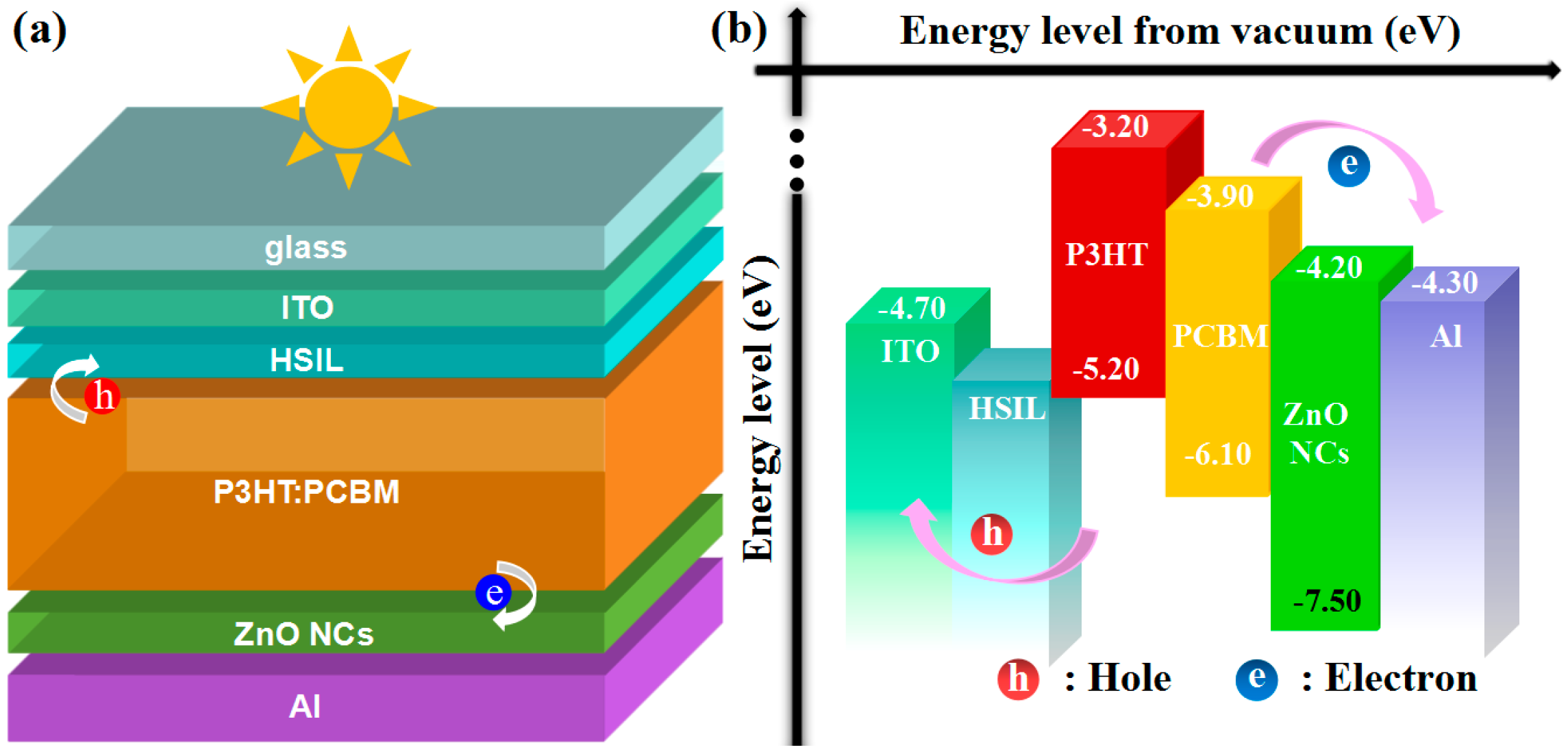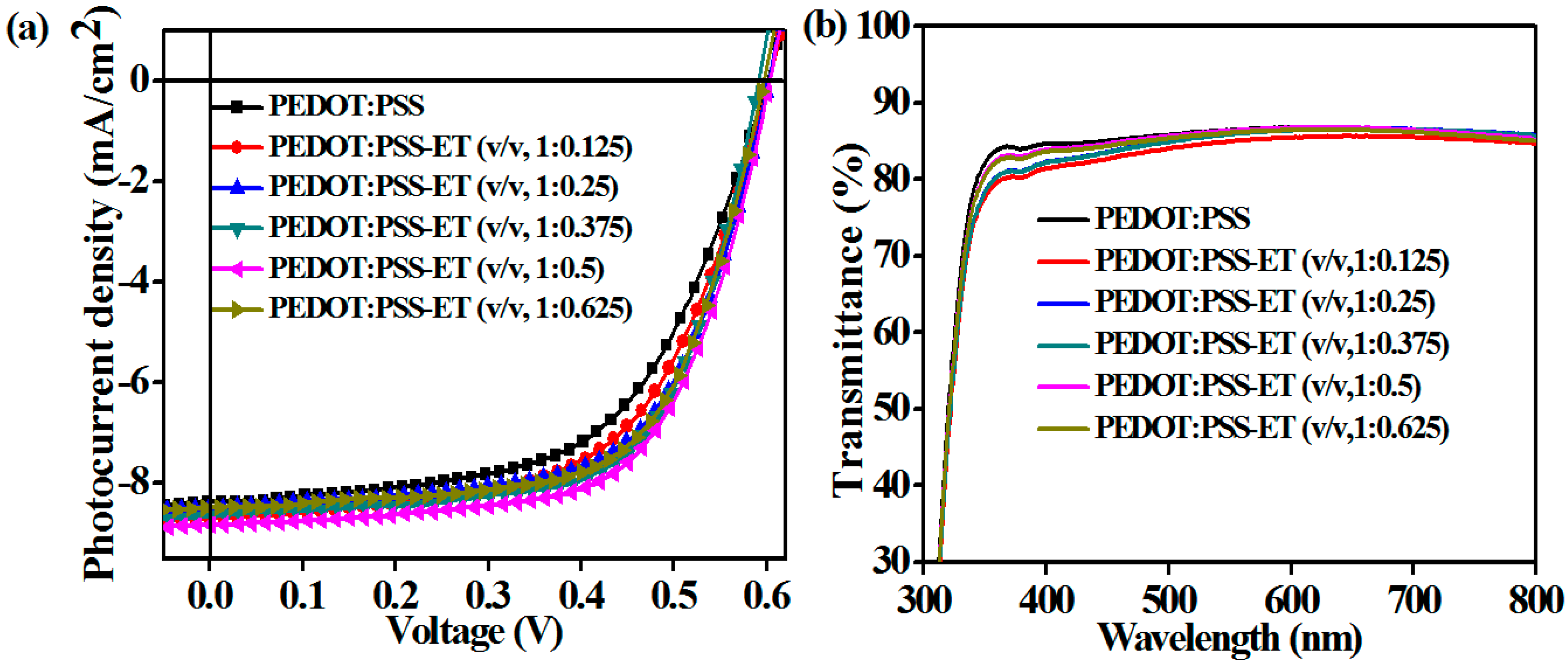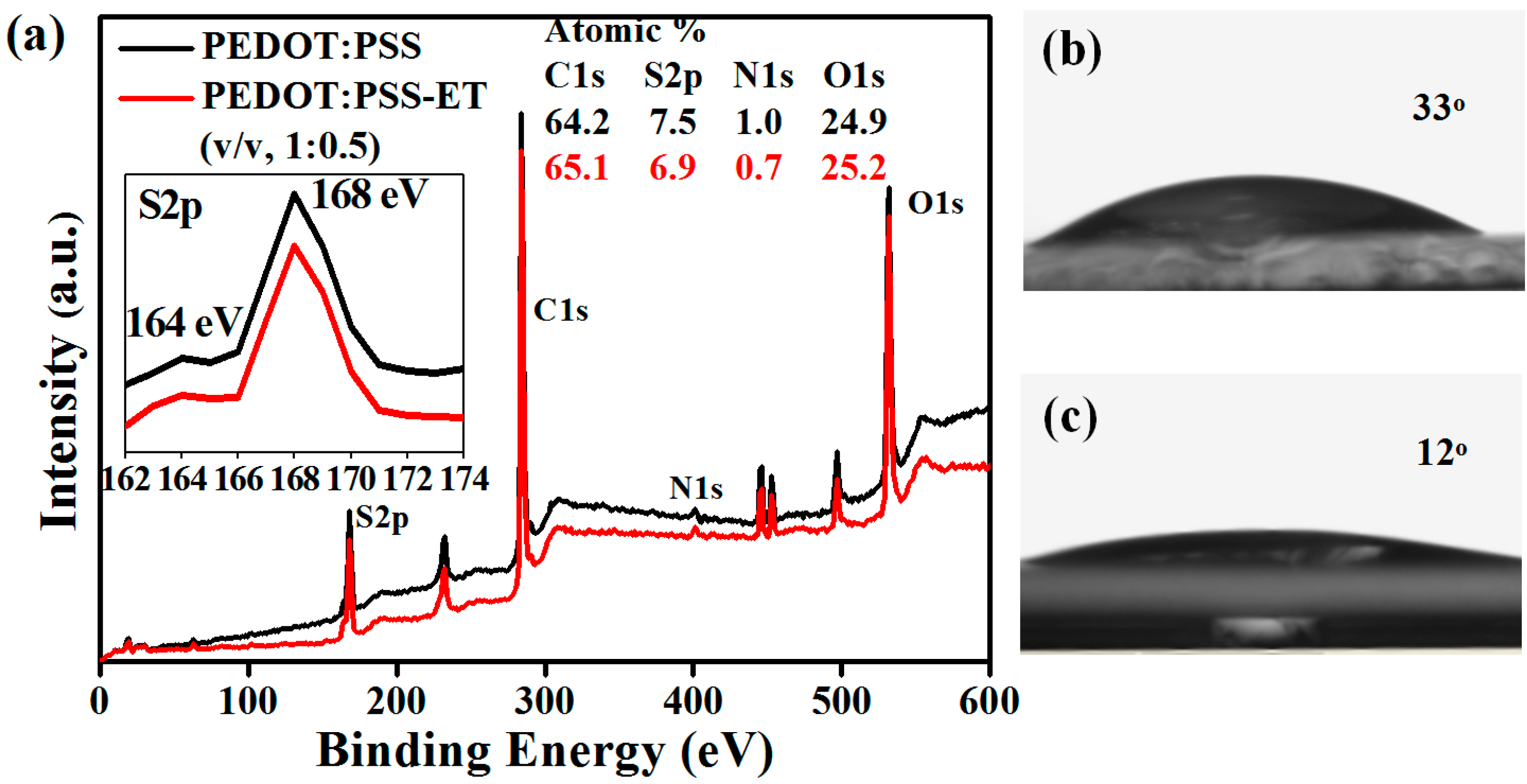Improving Air-Stability and Performance of Bulk Heterojunction Polymer Solar Cells Using Solvent Engineered Hole Selective Interlayer
Abstract
:1. Introduction
2. Materials and Methods
2.1. Materials and HSIL Preparation
2.2. Fabrication and Characterization of the BHJ-PSCs
2.3. Thin Film Characterization
3. Results
3.1. Photovoltaic Performance
3.2. Microstructural Properties
3.3. Surface Properties
3.4. Electronic Property
3.5. Air-Stability
4. Conclusions
Supplementary Materials
Author Contributions
Funding
Conflicts of Interest
References
- Li, G.; Zhu, R.; Yang, Y. Polymer solar cells. Nat. Photonics 2012, 6, 153. [Google Scholar] [CrossRef]
- Zhang, Z.; Li, X.; Guan, G.; Pan, S.; Zhu, Z.; Ren, D.; Peng, H. A lightweight polymer solar cell textile that functions when illuminated from either side. Angew. Chem. Int. Ed. 2014, 53, 11571–11574. [Google Scholar] [CrossRef] [PubMed]
- Sun, C.; Pan, F.; Bin, H.; Zhang, J.; Xue, L.; Qiu, B.; Wei, Z.; Zhang, Z.-G.; Li, Y. A low cost and high performance polymer donor material for polymer solar cells. Nat. Commun. 2018, 9, 743. [Google Scholar] [CrossRef] [PubMed]
- An, Q.; Zhang, F.; Zhang, J.; Tang, W.; Deng, Z.; Hu, B. Versatile ternary organic solar cells: A critical review. Energy Environ. Sci. 2016, 9, 281–322. [Google Scholar] [CrossRef]
- Zhao, W.; Qian, D.; Zhang, S.; Li, S.; Inganäs, O.; Gao, F.; Hou, J. Fullerene-free polymer solar cells with over 11% efficiency and excellent thermal stability. Adv. Mater. 2016, 28, 4734–4739. [Google Scholar] [CrossRef] [PubMed]
- Xiao, B.; Wu, H.; Cao, Y. Solution-processed cathode interfacial layer materials for high-efficiency polymer solar cells. Mater. Today 2015, 18, 385–394. [Google Scholar] [CrossRef]
- Zeng, H.; Zhu, X.; Liang, Y.; Guo, X. Interfacial layer engineering for performance enhancement in polymer solar cells. Polymers 2015, 7, 333–372. [Google Scholar] [CrossRef]
- Zhang, K.; Liu, X.-Y.; Xu, B.-W.; Cui, Y.; Sun, M.-L.; Hou, J.-H. High-performance fullerene-free polymer solar cells with solution-processed conjugated polymers as anode interfacial layer. Chin. J. Polym. Sci. 2017, 35, 219–229. [Google Scholar] [CrossRef]
- Glen, T.S.; Scarratt, N.W.; Yi, H.; Iraqi, A.; Wang, T.; Kingsley, J.; Buckley, A.R.; Lidzey, D.G.; Donald, A.M. Dependence on material choice of degradation of organic solar cells following exposure to humid air. J. Polym. Sci. Part B Polym. Phys. 2016, 54, 216–224. [Google Scholar] [CrossRef] [PubMed]
- Manzano-Ramírez, A.; López-Naranjo, E.J.; Soboyejo, W.; Meas-Vong, Y.; Vilquin, B. A review on the efficiency of graphene-based bhj organic solar cells. J. Nanomater. 2015, 2015, 15. [Google Scholar] [CrossRef]
- Wang, X.; Zhao, C.X.; Xu, G.; Chen, Z.-K.; Zhu, F. Degradation mechanisms in organic solar cells: Localized moisture encroachment and cathode reaction. Sol. Energy Mater. Sol. Cells 2012, 104, 1–6. [Google Scholar] [CrossRef]
- Hu, Z.; Zhang, J.; Hao, Z.; Zhao, Y. Influence of doped pedot: Pss on the performance of polymer solar cells. Sol. Energy Mater. Sol. Cells 2011, 95, 2763–2767. [Google Scholar] [CrossRef]
- Hou, X.; Li, Q.; Cheng, T.; Yu, L.; Wang, F.; Lin, J.; Dai, S.; Li, Y.; Tan, Z.A. Improvement of the power conversion efficiency and long term stability of polymer solar cells by incorporation of amphiphilic nafion doped pedot-pss as a hole extraction layer. J. Mater. Chem. A 2015, 3, 18727–18734. [Google Scholar] [CrossRef]
- Lattante, S. Electron and hole transport layers: Their use in inverted bulk heterojunction polymer solar cells. Electronics 2014, 3, 132–164. [Google Scholar] [CrossRef]
- Savva, A.; Georgiou, E.; Papazoglou, G.; Chrusou, A.Z.; Kapnisis, K.; Choulis, S.A. Photovoltaic analysis of the effects of pedot:Pss-additives hole selective contacts on the efficiency and lifetime performance of inverted organic solar cells. Sol. Energy Mater. Sol. Cells 2015, 132, 507–514. [Google Scholar] [CrossRef]
- Wang, M.; Zhou, M.; Zhu, L.; Li, Q.; Jiang, C. Enhanced polymer solar cells efficiency by surface coating of the pedot: Pss with polar solvent. Sol. Energy 2016, 129, 175–183. [Google Scholar] [CrossRef]
- Nagata, R.; Yanagi, Y.; Fujii, S.; Kataura, H.; Nishioka, Y. Application of highly conductive dmso-treated pedot:Pss electrodes to flexible organic solar cells. In Proceedings of the 2014 21st International Workshop on Active-Matrix Flatpanel Displays and Devices (AM-FPD), Kyoto, Japan, 2–4 July 2014; pp. 299–302. [Google Scholar]
- Keawprajak, A.; Koetniyom, W.; Piyakulawat, P.; Jiramitmongkon, K.; Pratontep, S.; Asawapirom, U. Effects of tetramethylene sulfone solvent additives on conductivity of pedot:Pss film and performance of polymer photovoltaic cells. Org. Electron. 2013, 14, 402–410. [Google Scholar] [CrossRef]
- Yang, J.S.; Oh, S.H.; Kim, D.L.; Kim, S.J.; Kim, H.J. Hole transport enhancing effects of polar solvents on poly(3,4-ethylenedioxythiophene):Poly(styrene sulfonic acid) for organic solar cells. ACS Appl. Mater. Interfaces 2012, 4, 5394–5398. [Google Scholar] [CrossRef] [PubMed]
- Hu, Z.; Zhang, J.; Zhu, Y. Effects of solvent-treated pedot: Pss on organic photovoltaic devices. Renew. Energy 2014, 62, 100–105. [Google Scholar] [CrossRef]
- Zhang, C.; Cheng, J.; Liao, X.; Lian, X.; Zhang, J.; Yang, X.; Li, L. Investigation of poly(3,4-ethylenedioxythiophene):Poly(styrenesulfonate) hole transport layer for solution-processed polymer solar cells. Int. J. Photoenergy 2015, 2015, 7. [Google Scholar] [CrossRef] [PubMed]
- Chen, C.-H.; LaRue, J.C.; Nelson, R.D.; Kulinsky, L.; Madou, M.J. Electrical conductivity of polymer blends of poly(3,4-ethylenedioxythiophene): Poly(styrenesulfonate): N-methyl-2-pyrrolidinone and polyvinyl alcohol. J. Appl. Polym. Sci. 2012, 125, 3134–3141. [Google Scholar] [CrossRef]
- Li, Q.; Yang, J.; Chen, S.; Zou, J.; Xie, W.; Zeng, X. Highly conductive pedot: Pss transparent hole transporting layer with solvent treatment for high performance silicon/organic hybrid solar cells. Nanoscale Res. Lett. 2017, 12, 506. [Google Scholar] [CrossRef] [PubMed]
- Ouyang, J.; Xu, Q.F.; Chu, C.W.; Yang, Y.; Li, G.; Shinar, J. On the mechanism of conductivity enhancement in poly (3,4-ethylenedioxythiophene): Poly(styrene sulfonate) film through solvent treatment. Polymer 2004, 45, 8443–8450. [Google Scholar] [CrossRef]
- Xu, B.; Gopalan, S.-A.; Gopalan, A.-I.; Muthuchamy, N.; Lee, K.-P.; Lee, J.-S.; Jiang, Y.; Lee, S.-W.; Kim, S.-W.; Kim, J.-S.; et al. Functional solid additive modified pedot:Pss as an anode buffer layer for enhanced photovoltaic performance and stability in polymer solar cells. Sci. Rep. 2017, 7, 45079. [Google Scholar] [CrossRef] [PubMed]
- Gopalan, S.-A.; Seo, M.-H.; Anantha-Iyengar, G.; Han, B.; Lee, S.-W.; Kwon, D.-H.; Lee, S.-H.; Kang, S.-W. Mild wetting poor solvent induced hydrogen bonding interactions for improved performance in bulk heterojunction solar cells. J. Mater. Chem. A 2014, 2, 2174–2186. [Google Scholar] [CrossRef]
- Sai-Anand, G.; Gopalan, A.-I.; Lee, K.-P.; Venkatesan, S.; Kang, B.-H.; Lee, S.-W.; Lee, J.-S.; Qiao, Q.; Kwon, D.-H.; Kang, S.-W. A futuristic strategy to influence the solar cell performance using fixed and mobile dopants incorporated sulfonated polyaniline based buffer layer. Sol. Energy Mater. Sol. Cells 2015, 141, 275–290. [Google Scholar] [CrossRef]
- Xu, B.; Sai-Anand, G.; Gopalan, A.-I.; Qiao, Q.; Kang, S.-W. Improving photovoltaic properties of p3ht:Ic60ba through the incorporation of small molecules. Polymers 2018, 10, 121. [Google Scholar] [CrossRef]
- Seemann, A.; Egelhaaf, H.J.; Brabec, C.; Hauch, J.A. Influence of Oxygen on Semi-Transparent Organic Solar Cells with Gas Permeable Electrodes. Org. Electron. 2009, 10, 1424–1428. [Google Scholar] [CrossRef]
- Norrman, K.; Gevorgyan, S.A.; Krebs, F.C. Water-induced degradation of polymer solar cells studied by h218o labeling. ACS Appl. Mater. Interfaces 2009, 1, 102–112. [Google Scholar] [CrossRef] [PubMed]
- Reese, M.O.; Morfa, A.J.; White, M.S.; Kopidakis, N.; Shaheen, S.E.; Rumbles, G.; Ginley, D.S. Pathways for the degradation of organic photovoltaic p3ht:Pcbm based devices. Sol. Energy Mater. Sol. Cells 2008, 92, 746–752. [Google Scholar] [CrossRef]
- Chen, Y.; Sun, Y.; Yu, C.; Li, F.; Wang, Y. Anode engineering of highly efficient polymer solar cells using treated ito. Chem. Res. Chin. Univ. 2016, 32, 689–694. [Google Scholar] [CrossRef]
- Alemu Mengistie, D.; Wang, P.-C.; Chu, C.-W. Effect of molecular weight of additives on the conductivity of pedot:Pss and efficiency for ito-free organic solar cells. J. Mater. Chem. A 2013, 1, 9907–9915. [Google Scholar] [CrossRef]
- Zhao, L.; Zhao, S.; Xu, Z.; Huang, D.; Zhao, J.; Li, Y.; Xu, X. The effects of improved photoelectric properties of pedot:Pss by two-step treatments on the performance of polymer solar cells based on ptb7-th:Pc71bm. ACS Appl. Mater. Interfaces 2016, 8, 547–552. [Google Scholar] [CrossRef] [PubMed]
- Peng, B.; Guo, X.; Cui, C.; Zou, Y.; Pan, C.; Li, Y. Performance improvement of polymer solar cells by using a solvent-treated poly(3,4-ethylenedioxythiophene):Poly(styrenesulfonate) buffer layer. Appl. Phys. Lett. 2011, 98, 243308. [Google Scholar] [CrossRef]
- Li, Z.; Meng, W.; Tong, J.; Zhao, C.; Qin, F.; Jiang, F.; Xiong, S.; Zeng, S.; Xu, L.; Hu, B.; et al. A nonionic surfactant simultaneously enhancing wetting property and electrical conductivity of pedot: Pss for vacuum-free organic solar cells. Sol. Energy Mater. Sol. Cells 2015, 137, 311–318. [Google Scholar] [CrossRef]
- Singh, V.; Arora, S.; Arora, M.; Sharma, V.; Tandon, R.P. Characterization of doped pedot: Pss and its influence on the performance and degradation of organic solar cells. Semicond. Sci. Technol. 2014, 29, 045020. [Google Scholar] [CrossRef]
- Kara, M.O.P.; Frey, M.W. Effects of solvents on the morphology and conductivity of poly(3,4-ethylenedioxythiophene):Poly(styrenesulfonate) nanofibers. J. Appl. Polym. Sci. 2014, 131. [Google Scholar] [CrossRef]
- Cho, W.; Im, S.; Kim, S.; Kim, S.; Kim, J. Synthesis and characterization of pedot:P(ss-co-vtms) with hydrophobic properties and excellent thermal stability. Polymers 2016, 8, 189. [Google Scholar] [CrossRef]
- Li, J.; Liu, J.; Gao, C.; Zhang, J.; Sun, H. Influence of mwcnts doping on the structure and properties of pedot:Pss films. Int. J. Photoenergy 2009, 2009, 1–5. [Google Scholar] [CrossRef]
- Chou, T.-R.; Chen, S.-H.; Chiang, Y.-T.; Lin, Y.-T.; Chao, C.-Y. Highly conductive pedot:Pss films by post-treatment with dimethyl sulfoxide for ito-free liquid crystal display. J. Mater. Chem. C 2015, 3, 3760–3766. [Google Scholar] [CrossRef]
- Xiong, S.; Zhang, L.; Lu, X. Conductivities enhancement of poly(3,4-ethylenedioxythiophene)/poly(styrene sulfonate) transparent electrodes with diol additives. Polym. Bull. 2012, 70, 237–247. [Google Scholar] [CrossRef]
- Farah, A.A.; Rutledge, S.A.; Schaarschmidt, A.; Lai, R.; Freedman, J.P.; Helmy, A.S. Conductivity enhancement of poly(3,4-ethylenedioxythiophene)-poly(styrenesulfonate) films post-spincasting. J. Appl. Phys. 2012, 112, 113709. [Google Scholar] [CrossRef]
- Zhu, Z.; Song, H.; Xu, J.; Liu, C.; Jiang, Q.; Shi, H. Significant conductivity enhancement of pedot:Pss films treated with lithium salt solutions. J. Mater. Sci. Mater. Electron. 2015, 26, 429–434. [Google Scholar] [CrossRef]
- Sai-Anand, G.; Han, B.; Kang, B.-H.; Kim, S.-W.; Lee, S.-W.; Lee, J.-S.; Jeong, H.-M.; Kang, S.-W. Incorporation of gold nanodots into poly(3,4-ethylenedioxythiophene):Poly(styrene sulfonate) for an efficient anode interfacial layer for improved plasmonic organic photovoltaics. J. Nanosci. Nanotechnol. 2015, 15, 7092–7098. [Google Scholar] [CrossRef] [PubMed]
- Ouyang, L.; Musumeci, C.; Jafari, M.J.; Ederth, T.; Inganäs, O. Imaging the phase separation between pedot and polyelectrolytes during processing of highly conductive pedot: Pss films. ACS Appl. Mater. Interfaces 2015, 7, 19764–19773. [Google Scholar] [CrossRef] [PubMed]
- Takeya, U.; Muneki, Y.; Arao, N.; Hideo, K. Segmentation of conducting domains in pedot:Pss films induced by an additive for conductivity enhancement. Appl. Phys. Express 2016, 9, 051601. [Google Scholar]
- Thomas, J.P.; Zhao, L.; McGillivray, D.; Leung, K.T. High-efficiency hybrid solar cells by nanostructural modification in pedot:Pss with co-solvent addition. J. Mater. Chem. A 2014, 2, 2383–2389. [Google Scholar] [CrossRef]
- Araźna, A.; Janeczek, K.; Futera, K.; Koziol, A. Modification of conductive polymer PEDOT:PSS layer by SWCNT. IOP Conf. Ser. Mater. Sci. Eng. 2016, 104, 012027. [Google Scholar] [Green Version]
- Sai-Anand, G.; Dubey, A.; Gopalan, A.-I.; Venkatesan, S.; Ruban, S.; Reza, K.M.; Choi, J.; Lakhi, K.S.; Xu, B.; Qiao, Q.; et al. Additive assisted morphological optimization of photoactive layer in polymer solar cells. Sol. Energy Mater. Sol. Cells 2018, 182, 246–254. [Google Scholar] [CrossRef]
- Deetuam, C.; Weise, D.; Samthong, C.; Praserthdam, P.; Baumann, R.R.; Somwangthanaroj, A. Electrical conductivity enhancement of spin-coated pedot:Pss thin film via dipping method in low concentration aqueous dmso. J. Appl. Polym. Sci. 2015, 132. [Google Scholar] [CrossRef]
- Zhu, Q.; Bao, X.; Yu, J.; Yang, R.; Dong, L. Simple synthesis of solution-processable oxygen-enriched graphene as anode buffer layer for efficient organic solar cells. Org. Electron. 2015, 27, 143–150. [Google Scholar] [CrossRef]
- Sai-Anand, G.; Gopalan, A.-I.; Lee, K.-P.; Venkatesan, S.; Qiao, Q.; Kang, B.-H.; Lee, S.-W.; Lee, J.-S.; Kang, S.-W. Electrostatic nanoassembly of contact interfacial layer for enhanced photovoltaic performance in polymer solar cells. Sol. Energy Mater. Sol. Cells 2016, 153, 148–163. [Google Scholar] [CrossRef]
- Cellot, G.; Lagonegro, P.; Tarabella, G.; Scaini, D.; Fabbri, F.; Iannotta, S.; Prato, M.; Salviati, G.; Ballerini, L. Pedot: Pss interfaces support the development of neuronal synaptic networks with reduced neuroglia response in vitro. Front. Neurosci. 2016, 9, 521. [Google Scholar] [CrossRef] [PubMed] [Green Version]
- Gopalan, S.-A.; Gopalan, A.-I.; Vinu, A.; Lee, K.-P.; Kang, S.-W. A new optical-electrical integrated buffer layer design based on gold nanoparticles tethered thiol containing sulfonated polyaniline towards enhancement of solar cell performance. Sol. Energy Mater. Sol. Cells 2018, 174, 112–123. [Google Scholar] [CrossRef]
- Xing, Y.-J.; Qian, M.-F.; Guo, D.-Z.; Zhang, G.-M. Increased work function in pedot: Pss film under ultraviolet irradiation. Chin. Phys. B 2014, 23, 038504. [Google Scholar] [CrossRef]
- Hwang, J.; Amy, F.; Kahn, A. Spectroscopic study on sputtered pedot·pss: Role of surface pss layer. Org. Electron. 2006, 7, 387–396. [Google Scholar] [CrossRef]
- Vida, T.; Sebastian, E.; Nikos, T.; Harald, H.; Morten, M.; Horst-Günter, R.; Uwe, R.; Gerhard, G. Long-term stabilization of organic solar cells using uv absorbers. J. Phys. D Appl. Phys. 2016, 49, 125604. [Google Scholar]
- Zhang, Y.; Chen, L.; Hu, X.; Zhang, L.; Chen, Y. Low work-function poly(3,4-ethylenedioxylenethiophene): Poly(styrene sulfonate) as electron-transport layer for high-efficient and stable polymer solar cells. Sci. Rep. 2015, 5, 12839. [Google Scholar] [CrossRef] [PubMed]







| HSIL | Voc (V) | Jsc (mA/cm2) | Rs (Ω) | FF | PCEa (%) | PCEb (%) |
|---|---|---|---|---|---|---|
| pristine | 0.59 ± 0.006 | 8.376 ± 0.07 | 241 ± 9.3 | 0.58 ± 0.016 | 2.92 | 2.86 ± 0.094 |
| 1:0.125 | 0.59 ± 0.004 | 8.421 ± 0.04 | 195 ± 8.5 | 0.59 ± 0.006 | 3.10 | 3.08 ± 0.012 |
| 1:0.25 | 0.60 ± 0.004 | 8.565 ± 0.03 | 170 ± 3.7 | 0.63 ± 0.005 | 3.22 | 3.21 ± 0.015 |
| 1:0.375 | 0.60 ± 0.004 | 8.652 ± 0.06 | 162 ± 4.6 | 0.63 ± 0.007 | 3.33 | 3.30 ± 0.016 |
| 1:0.5 | 0.60 ± 0.005 | 8.890 ± 0.05 | 155 ± 5.8 | 0.64 ± 0.004 | 3.42 | 3.36 ± 0.041 |
| 1:0.625 | 0.59 ± 0.005 | 8.572 ± 0.08 | 159 ± 6.4 | 0.63 ± 0.005 | 3.27 | 3.22 ± 0.035 |
| PEDOT:PSS-ET (v/v) | pH Value |
|---|---|
| Pristine | 1.65 |
| 1:0.125 | 1.77 |
| 1:0.25 | 1.96 |
| 1:0.375 | 1.99 |
| 1:0.5 | 2.04 |
| 1:0.625 | 2.14 |
| ET | 6.87 |
© 2018 by the authors. Licensee MDPI, Basel, Switzerland. This article is an open access article distributed under the terms and conditions of the Creative Commons Attribution (CC BY) license (http://creativecommons.org/licenses/by/4.0/).
Share and Cite
Xu, B.; Sai-Anand, G.; Jeong, H.-M.; Kim, S.-W.; Kim, J.-S.; Kwon, J.-B.; Kang, S.-W. Improving Air-Stability and Performance of Bulk Heterojunction Polymer Solar Cells Using Solvent Engineered Hole Selective Interlayer. Materials 2018, 11, 1143. https://doi.org/10.3390/ma11071143
Xu B, Sai-Anand G, Jeong H-M, Kim S-W, Kim J-S, Kwon J-B, Kang S-W. Improving Air-Stability and Performance of Bulk Heterojunction Polymer Solar Cells Using Solvent Engineered Hole Selective Interlayer. Materials. 2018; 11(7):1143. https://doi.org/10.3390/ma11071143
Chicago/Turabian StyleXu, Binrui, Gopalan Sai-Anand, Hyun-Min Jeong, Sae-Wan Kim, Ju-Seong Kim, Jin-Beom Kwon, and Shin-Won Kang. 2018. "Improving Air-Stability and Performance of Bulk Heterojunction Polymer Solar Cells Using Solvent Engineered Hole Selective Interlayer" Materials 11, no. 7: 1143. https://doi.org/10.3390/ma11071143






